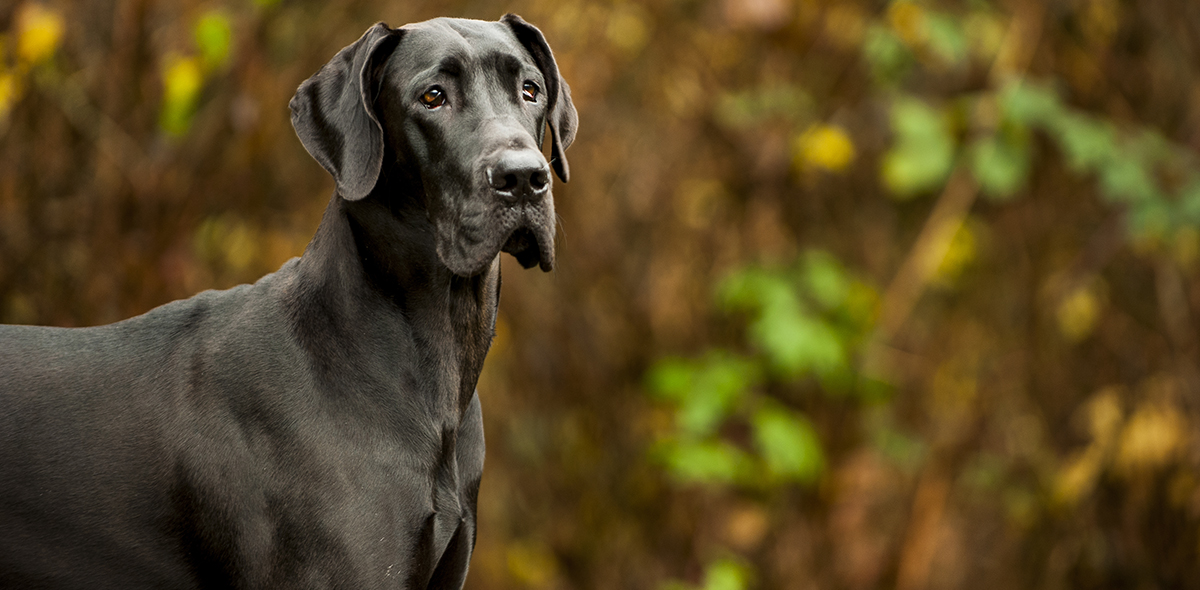Great Dane Dog Breed Information
Quick Great Dane Facts:
- Height: 28-32 inches (female), 30-34 inches, (male)
- Weight: 99-130 pounds (female), 120-200 pounds (male)
- Lifespan: 7-10 years
- Temperament: Friendly, devoted
- Fun fact: The tallest dog ever was a Great Dane!
Among the most popular of dog breeds, the Great Dane is the American Kennel Club’s 14th most popular breed. Appropriately named the “Apollo of Dogs,” they are both mighty and easygoing. Their size requires committed ownership, so if you’re thinking of bringing a Great Dane into your home, here is what you need to know.
A Little History
Great Danes are not Danish, though their names might imply otherwise. Descending from the Greyhound and the Molussus (an ancient war dog), the first Great Danes were born in 14th century Germany. No one is quite sure why they are called Great Danes, as they do not have Danish origins. They are also known in Germany as the Deutsche Dogge, and as the German Boarhound in Britain. One of their earliest responsibilities was to hunt and capture wild boar. By the 1800s, breed clubs emerged in America and Germany, and today they are revered among the most powerful and beautiful of breeds.
What are Great Danes Like?
At a glance, one of the most distinguishing characteristics of the Great Dane is its size. With shoulders as high as 32 inches from the ground, many Great Danes are taller than humans when standing on their hind legs. Their gait is elegant and graceful, in a stark contrast to their sheer strength. While their coats can come in many colors and patterns, the most prominent and well-known combination is black with white patchwork, commonly called “harlequin.”
Despite their demeaning stature, Great Danes are gentle and patient. They do well with children and other pets, and generally aim to please the people around them. They also make new friends with relative ease, but that does not mean they are not watch dogs. Most intruders would not dare test a dog of such might, but those who would dare would come to regret it. The Great Dane is a brave and spirited defender.
Caring for Great Danes
Though they look tough, Great Danes are quite delicate. They are not suited for outdoor living, but instead should have ample space indoors and with a soft bed for resting. Nevertheless, they require routine activity, so take long walks and engage in playtime. While they do not shed much, remember that they are a lot larger than most dogs, so their hair may still accumulate in your home. A daily brushing will help to control shedding while also helping to keep their coat healthy and comfortable. An occasional bath is recommended, and trimming their nails regularly helps to prevent splitting and cracking which can be painful. Of course, remember to brush their teeth to prevent dental disease.
Great Danes are prone to conditions such as Hypothyroidism, Canine Hip Dysplasia (CHD), and Gastric Torsion1. It’s important to schedule regular check-ups with your veterinarian to monitor for health concerns. It may also be helpful to identify the nearest Emergency Veterinary practice, in case of an emergency.
The Cost
The cost of adopting a Great Dane can vary depending upon its pedigree. Some breeders will only charge about $600, while others will require as much as $3,000. You should also plan to spend upwards of $500 on supplies and initial veterinary expenses. Each year after that, veterinary care can cost around $800 a year. Conditions such as Canine Hip dysplasia and Gastric Torsion can cost anywhere between $1,000 to $5,000 to treat. A policy from 4Paws Insurance helps to offset unexpected medical costs like these.
Sandy Says
Comments from our Chief Pet Officer
I have several friends that enjoy the company of Great Danes. They constantly say how mellow, loving, and low maintenance their Great Danes tend to behave. Interestingly, Great Danes make great apartment dogs as they require less exercise and prefer to lay around the house as they age. To help manage them when they get older, I recommend obedience training. As is the case with most large breeds, they will require a lot of food.
Sources
https://www.akc.org
https://www.dogbreedinfo.com
https://www.petmd.com/dog/breeds/c_dg_Great_Dane1
